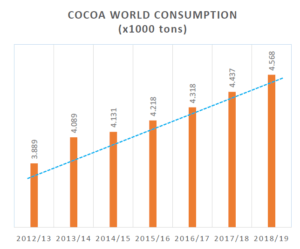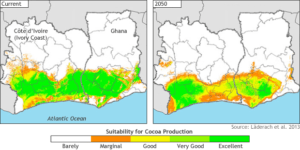Chocapocalypse: Is Chocolate Endangered?
The future of your favorite candy may be in danger. Snickers and M&Ms are household brands that we naturally associate with chocolate. Although most consumers may not connect climate change with the chocolate industry, Mars Company and others are increasingly focused on the sustainability of the ingredients that go into their iconic products. “Weather has a much larger, longer-term impact on business that isn’t getting the attention it deserves,” says Greg Harnish, Mars Chocolate North America’s commercial vice president [1]. In fact, Mars has its own dedicated team of meteorologists to help executives make critical supply chain and sourcing decisions. The Mars meteorologists examine current weather patterns and coordinate with other departments to work around potential supplier disruptions [1]. These events range from thunderstorms to more dramatic shifts in weather, which call into question the sustainability of chocolate manufacturing and procurement practices.
Demand for cocoa is rising at a rate of 2% each year and the world could face a shortage in supply by 2020 as shown in Figure 1[2]. Expected temperature increases, a result of climate change, are projected to have a significant impact on farmers. Cocoa trees are sensitive to shifts in weather patterns such as droughts, rain, wind, and fluctuating temperatures, which can negatively impact crop yields [3]. As a result, areas that are currently ideal for cocoa cultivation may become unusable in the not so distant future. The Cacao tree thrives in humid and rainy climates with nitrogen-rich soil such as Côte d’Ivoire, Ghana, and Indonesia and these countries will likely undergo a 3.8˚F increase by 2050[4]. This shift will result in atmospheric moisture loss and decrease the amount of usable land for cocoa farming. In fact, 10.5% of locations examined show increased suitability for cocoa production, while the remaining 89.5% will become less suitable by 2050 as shown in Figure 2[4].
Figure 1:
The World Bank
Figure 2: Suitability of Cocoa Cultivation
Climate.gov
Although meteorologists at the Mars Company are able to accurately predict current weather patterns to accurately inform short-term strategy, the Company is seeking proactive ways to address long-term climate change concerns and finding ways to minimize the gap between future chocolate supply and demand. In 2008, Mars launched the Cacao Genome Project with IBM and the US Department of Agriculture to “sequence, assemble, and annotate the genome of the cacao tree” [5]. The Company has shared this genome research to allow breeders to find ways to make the tree less susceptible to climate change and hopefully enhance yields for farmers.
Mars Website
On a more comprehensive level, Mars created the Sustainable in a Generation Program to reduce emissions and fossil fuel energy use to zero by 2040. The Company plans to achieve this goal with a four-pronged approach[6]:
- Operational Efficiency: Cut down energy and water usage and waste through organization changes to processes
- Capital Efficiency: Invest in efficient equipment and processes
- New Technology: Innovate and deploy new innovations
- Renewable Energy: Partner with others to generate cleaner power
As of 2015, the Company has successfully reduced total energy usage by 5% and fossil fuel usage by 18% vs 2007 levels [7].
In addition to the various climate change initiatives that Mars has put in place, the Company should take additional steps to ensure predictable and high-quality procurement. Mars can invest in its cocoa farmers, affording the Company a predicable supply by reducing the risk of price fluctuations and shortages. Mars can also benefit from process synergies by sharing best practices with its partner farmers. According to chocolate producers, farmers could grow 1,500 kilograms per hectare if they have access to the right resources and best practices whereas the current output is 500 kilograms per hectare [8]. By partnering with or acquiring these suppliers, Mars can work with farmers to increase yields and work towards more sustainable methods to produce cocoa.
Word Count: 641
[1] Kate Taylor, “The Smart Reason the World’s Largest Candy Maker is Hiring Meteorologists, Business Insider, September 28, 2016, http://www.businessinsider.com/mars-chocolate-hires-meteorologists-to-deal-with-climate-change-2016-9, accessed November 2016.
[2] “Simeon Ehui Global Agriculture Practice Manager for Africa The World Bank Group”, in WCF’s Partnership Meeting & Cocoa Sustainability Trade Fair 2015 Conference, Washington, DC. June 30-July 1 2015, pp 25, 39.
[3] “Cocoa Market Update”, worldcocoafoundation.com, April 1, 2014, http://www.worldcocoafoundation.org/wp-content/uploads/Cocoa-Market-Update-as-of-4-1-2014.pdf, accessed November 2016.
[4] Michon Scott, “Climate and Chocolate”, Climate.gov, February 10, 2016, https://www.climate.gov/news-features/climate-and/climate-chocolate, accessed November 16, 2016.
[5] Mars Company, “Environment”, http://www.mars.com/global/science-and-innovation/science/environment, accessed November 2016.
[6] Mars Company, “Operations”, http://www.marsgcc.com/global/sustainability/operations, accessed November 2016.
[7] Mars Company, “Energy-Climate”, http://www.marsgcc.com/global/sustainability/operations/energy-climate, accessed November 2016.
[8] Alexandra Wexler, “Chocolate Makers Fight a Melting Supply of Cocoa”, The Wall Street Journal, January 13, 2016, http://www.wsj.com/articles/chocolate-makers-fight-a-melting-supply-of-cocoa-1452738616, accessed November 2016.






Ashely, super interesting to look at Mars’ initiatives to respond to climate change. I’m surprised at their goals and the results of their efforts to date.
I think you are spot on in your recommendation for Mars to focus on smoothing sourcing by investing in farmer resilience. In Ghana, the price per bag of cocoa is set by a government-run Cocoa Board because it is such a key export for the country. So price volatility to farmers or companies is set more reliably than with other crops, but there is huge variability in whether farmers’ cocoa will actually meet quality standards for that price. Purchasing clerks from the Board throughout the country evaluate whether each bag of cocoa is adequately dried, mostly whole-bean, uniform in size, etc. When farmers have limited knowledge of best practices, or limited access to improved farming tools, their income, and the volume of product for purchasers like Mars, plummet significantly.
I was disappointed that improving these practices was not a major part of Mars’ Sustainability plan as you recommended. The plan seemed limited to focusing on energy and process efficiencies. Not only does this overlook a major concern in cocoa sourcing, I was not impressed that even these goals only saw 5% and 18% improvements in an eight year period.
As an excessive consumer of chocolate, I hope that Mars can push themselves toward more holistic goals, and more ambitious execution of them in the future, for all our sakes…
Thanks for flagging a potentially very serious problem. I’m really hopeful that Mars can mitigate the effects of climate change on their cocoa crop, and would be interested in seeing the way they use technology to create more genetically robust strains of cocoa. Despite the bad press here in the US, I think this is an instance of a time when the right lab-produced GMO could make a big difference. My hope would be that Mars starts setting up cocoa bean tests where it can develop drought resistant plants more quickly than a simple genetic analysis might allow. Sounds like they’re being a bit cagey about how they design new strains, but in my opinion we can’t get a stronger bean fast enough – I’d be hard pressed to survive a long chocolate shortage.
What will I do without chocolate? I’m glad you pointed out the fact that chocolate is indeed one of the foods that may be in danger with the growing climate change crisis. Given that the shortage is expected to begin as early as 2020, I’m surprised that the changes haven’t been huge. I’d be really interested to know in more detail, what Mars is doing internally to combat this, and what it is doing potentially with other chocolate-makers around the world. Given that the demand is strong and increasing every year, I would expect that something major is going on!!
I would have never guessed that a company like Mars employs meteorologists to predict weather patterns for supply chain purchases- it’s brilliant! It would be interesting to know whether Mars and/or similar chocolate companies have always hired meteorologists given how delicate the Cocoa plant is or if these companies began recruiting meteorologists when they noticed the effects of climate change. I also wonder what initiatives the governments of Côte d’Ivoire, Ghana, and Indonesia have instituted locally assuming that cocoa production is a high proportion of GDP and job provider in these countries.
No Chocolate in 4 years??
As AT mentioned above, I was also pleasantly surprised that Mars employed meteorologist. I was also very impressed by their target goal of reducing emissions and fossil fuel energy usage to zero by 2040! My biggest questions is whether Mars could be doing more?
In particular from a consumer educations front? Given they represent ~29% of the confectionery market share in the US in 2015, could they be using their platform to educate consumers about the dangers of climate change?
So far, much of the consumer education for climate change has either been negative advertising or very scientific studies. Given the debatable studies on whether negative advertising actually works, I could see an opportunity for Mars to become a positive advocate for change. Potentially using their humorous advertising as a way to encourage better behavior.